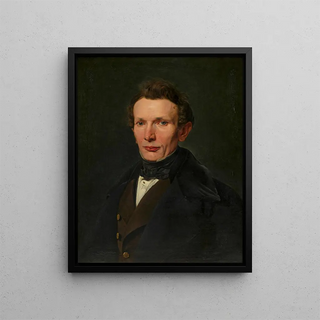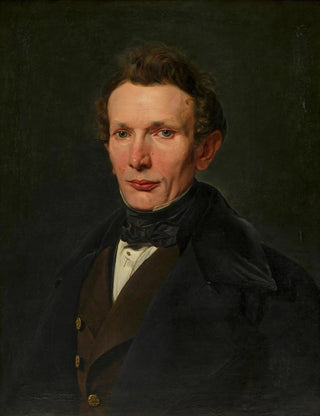Art print | Monsieur von Bartsch - Ferdinand Georg Waldmüller


View from behind

Frame (optional)
In the vast panorama of art history, some works stand out for their ability to capture not only a moment but also the very essence of an era. "Monsieur von Bartsch - Ferdinand Georg Waldmüller" is one of these creations that evoke a rich narrative and emotional depth. This piece, imbued with unmatched delicacy and precision, immerses us in the universe of the 19th century, where the Austrian artist masterfully blended realism and sensitivity. Waldmüller, through his brush, offers a window into a society in full transformation, while celebrating the beauty of the individuals who compose it.
Style and uniqueness of the work
Waldmüller's style is characterized by meticulous attention to detail and a capacity to convey human emotions with rare intensity. In "Monsieur von Bartsch," each brushstroke seems to tell a story, each facial expression is loaded with meaning. The artist manages to capture not only the physical traits of his subject but also their character and essence. The light, omnipresent in his work, plays a fundamental role, creating shadow and reflection effects that add an almost tangible dimension to the scene. This painting is a perfect example of how Waldmüller transcends the simple portrait to offer a true psychological study of his models. In this, he stands out from the conventions of his time, proposing a more intimate and human vision.
The artist and his influence
Ferdinand Georg Waldmüller, an emblematic figure of Austrian Romanticism, left an indelible mark on European art. Born in 1793, he skillfully navigated the artistic currents of his time, integrating elements of realism while drawing inspiration from classical traditions. His ability to depict everyday life with such depth influenced many artists, both of his era and subsequent generations. Waldmüller was also a pioneer in the use of color and light, elements that would become essential pillars in the development of Impressionism. His work "Monsieur von Bartsch" is not only a testament to his talent but also a

Matte finish

View from behind

Frame (optional)
In the vast panorama of art history, some works stand out for their ability to capture not only a moment but also the very essence of an era. "Monsieur von Bartsch - Ferdinand Georg Waldmüller" is one of these creations that evoke a rich narrative and emotional depth. This piece, imbued with unmatched delicacy and precision, immerses us in the universe of the 19th century, where the Austrian artist masterfully blended realism and sensitivity. Waldmüller, through his brush, offers a window into a society in full transformation, while celebrating the beauty of the individuals who compose it.
Style and uniqueness of the work
Waldmüller's style is characterized by meticulous attention to detail and a capacity to convey human emotions with rare intensity. In "Monsieur von Bartsch," each brushstroke seems to tell a story, each facial expression is loaded with meaning. The artist manages to capture not only the physical traits of his subject but also their character and essence. The light, omnipresent in his work, plays a fundamental role, creating shadow and reflection effects that add an almost tangible dimension to the scene. This painting is a perfect example of how Waldmüller transcends the simple portrait to offer a true psychological study of his models. In this, he stands out from the conventions of his time, proposing a more intimate and human vision.
The artist and his influence
Ferdinand Georg Waldmüller, an emblematic figure of Austrian Romanticism, left an indelible mark on European art. Born in 1793, he skillfully navigated the artistic currents of his time, integrating elements of realism while drawing inspiration from classical traditions. His ability to depict everyday life with such depth influenced many artists, both of his era and subsequent generations. Waldmüller was also a pioneer in the use of color and light, elements that would become essential pillars in the development of Impressionism. His work "Monsieur von Bartsch" is not only a testament to his talent but also a






